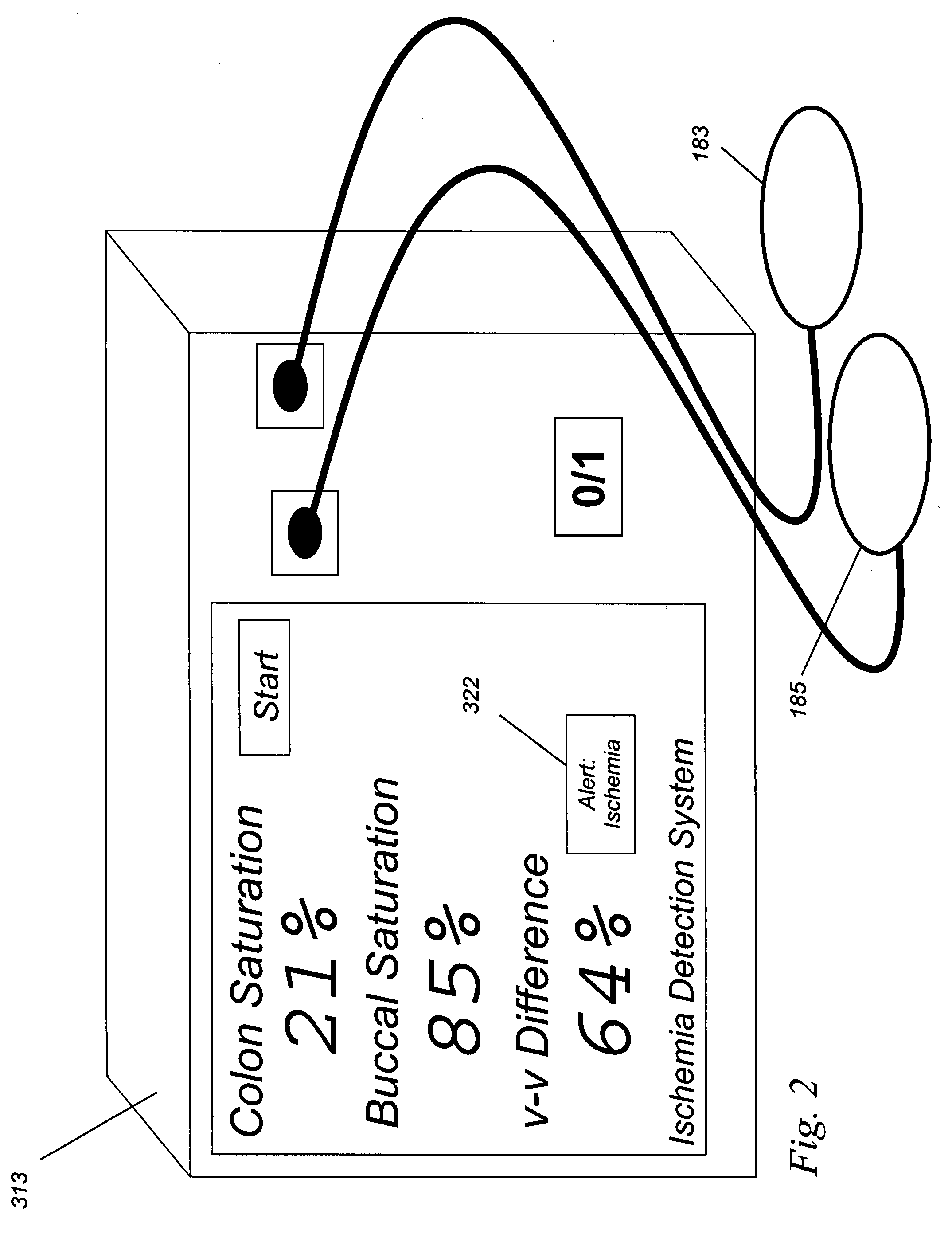Difference-weighted somatic spectroscopy
a somatic spectroscopy and difference-weighted technology, applied in the field of determination of a difference-weighted analysis, can solve the problems of not being suitable for somatic monitoring, devices that do not allow for mutual or computational determination of a difference-weighted value, and difficulty in determining the source of tissue oxygenation changes, etc., to achieve low cardiac output, improve real-time feedback, and improve the effect of oxygen delivery
- Summary
- Abstract
- Description
- Claims
- Application Information
AI Technical Summary
Benefits of technology
Problems solved by technology
Method used
Image
Examples
example 1
Simultaneous Two-Site Two-Organ Somatic Difference Monitoring
[0047] In this example, a clinical application related to ischemia is described. Here, a surgeon is repairing the aorta. There are several reasons why the local tissue oxygenation may fall. For example, the patient is under anesthesia, and a general depression (reduction) of cardiac output may occur. If so, the delivery of oxygen to all parts of the body will fall. On the other hand, if the blood vessel supplying the colon, which arises in part from the aorta, is occluded, then the saturation to the colon will fall, but not the saturation to the cheek. Therefore, by looking at the saturation of both the cheek and colon at substantially the same time, or by displaying a difference between the two values, the cause of the drop in local oxygenation may be determined to be either local and due to the vascular repair (e.g., large difference, in this case the absolute value of |Δ saturation| >10%) which is an indication of loca...
example 2
Simultaneous Two-Site Single-Organ Somatic Difference Monitoring
[0051] In the example above, two different organs were studied. In this example, the monitoring of a single organ, the breast, is described. It is toward this Example that the embodiment of FIG. 1 is directed.
[0052] In breast cancer, the detection of angiogenesis, the proliferation of new blood vessels, is a key feature of cancer that lets the cancer gain the ability to grow and spread. However, the background variation in blood content in the breast between women of different ages and breast composition makes the use of a single-site blood-content threshold less useful than it could otherwise be. That is, the range of normal blood content in breast tissue between different women is so large that the increase in blood due to cancer can be lost in that broad range.
[0053] To illustrate this, consider data from women with breast cancer. By looking at the difference measurement of the oxygenation at one location on the b...
example 3
Multi-Site Single-Organ Somatic Difference Monitoring
[0055] In the above example, pairs of data were taken, one pair at a time. In this example, instead of plotting values from a single pair, embodiments of the present invention provide for plotting real time difference values from many measures at many sites.
[0056] Again, using data from human subjects with and without breast cancer, the following table can be generated. Such differences can be found by having a difference in spatial separation at two points, as shown as the difference (delta) values at 5 sites labeled A-E on each subject, as follows:
TABLE 3The Spatial difference at multiple sites by plotting differences,reduces the noise in breast tissue saturation, and allows simpledetection of tumor near site C of Patient Tumor 4,in which the saturation difference has a negative thenpositive deflection (or vice-versa) during scanning.PatientΔ Site AΔ Site BΔ Site CΔ Site DΔ Site ENormal 12% 4% 3% 5%−3%Normal 20%−2% 3%...
PUM
 Login to View More
Login to View More Abstract
Description
Claims
Application Information
 Login to View More
Login to View More - R&D
- Intellectual Property
- Life Sciences
- Materials
- Tech Scout
- Unparalleled Data Quality
- Higher Quality Content
- 60% Fewer Hallucinations
Browse by: Latest US Patents, China's latest patents, Technical Efficacy Thesaurus, Application Domain, Technology Topic, Popular Technical Reports.
© 2025 PatSnap. All rights reserved.Legal|Privacy policy|Modern Slavery Act Transparency Statement|Sitemap|About US| Contact US: help@patsnap.com



